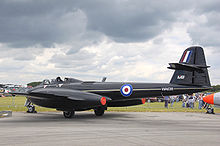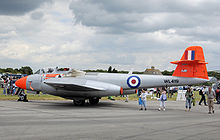Martin-Baker Aircraft Co. Ltd. - Corporate Video Promoting Ejection Seats
|
|
Martin-Baker
Industry: Aircraft Ejection Systems
Founded: 1934
Founder(s): Sir James Martin
Captain Valentine Baker
Headquarters: Denham, Buckinghamshire, UK
Website: www.martin-baker.com
Martin-Baker Aircraft Co. Ltd. is a manufacturer of ejection seats and safety related equipment for aviation. The company origins were as an aircraft manufacturer before becoming a pioneer in the field of ejection seats. The company's headquarters are in Higher Denham, Buckinghamshire, England with other locations in France, Italy and United States.
Martin-Baker supplies ejection seats for 93 air forces worldwide. The Martin-Baker company is the only company to offer a fully integrated escape system which meets the latest pilot operational capability and safety standards. Martin-Baker seats have been fitted into over 80 fixed-wing and rotary types with the most recent being the JSF F-35 programme.
Since the first live ejection test in 1946, 7,334 lives have been saved by Martin-Baker ejection seats.
History
Martin-Baker was founded as an aircraft manufacturer in 1934 by Captain (later Sir) James Martin and Captain Valentine Baker.
Martin and Baker had designed an unconventional, two-place, low wing monoplane design in the early 1930s. This was powered by a de Havilland Gipsy engine mounted in the fuselage behind the seats and driving a fixed pitch propeller through a shaft running horizontally between the pilot and passenger. The project was abandoned due to financial constraints, although the fuselage and engine installation had been completed. Martin-Baker also constructed an autogyro designed by Raoul Hafner. This, their first complete aircraft project, was later tested by Captain Baker at Heston Aerodrome.
Martin-Baker designed and produced several prototype military aircraft before and during the Second World War, although none entered production:
Martin-Baker M.B.1 (1935) - a two-seat light aircraft
Martin-Baker M.B.2 (1938) - a Napier-powered fighter prototype.
Martin-Baker M.B.3 (1942) - a six-cannon fighter design, powered by a Napier Sabre; Val Baker was killed in a crash while testing the prototype.
Martin-Baker M.B.4 (1943) - a Griffon-engined fighter, cancelled on the drawing board
Martin-Baker M.B.5 (1944) - a Griffon-engined fighter with contra-rotating propellors.
Martin-Baker M.B.6 (1945) - a Second World War jet fighter project with a swing-arm, 0/0 spring-loaded ejection seat
Martin-Baker M.B.7 (1946) - Black Bess - a postwar interceptor/high-speed test aircraft concept. Small flying models were made but the concept was cancelled in 1947.
Martin-Baker manufactured aircraft components, including armoured seats for Supermarine Spitfires, throughout the Second World War. In 1944 the company was approached by the Ministry of Aircraft Production to investigate ejection systems enabling pilots to bail out safely from high-speed fighter aircraft.
Ejection seats

Picture - Gloster Meteor WA638, owned by Martin-Baker and used for ejection seat tests
Martin-Baker investigated ejection seats from 1934 onward, several years before Germany (1938) and Sweden. The company concluded that an explosive-powered ejection seat was the best solution.
In 1944, James Martin was invited by the then Ministry of Aircraft Production to investigate the practicability of providing fighter aircraft with a means of assisted escape for the pilot.
The need for such an escape system was accentuated by the death in January 1944, of a Royal Aircraft Establishment Test Pilot who encountered an emergency whilst testing an early version of the Gloster Meteor. Although he escaped from the aircraft by the standard over the side technique, he was injured in the process, lost consciousness and consequently made no attempt to open his parachute. After investigating alternative schemes, it soon became apparent that the most attractive means would be by forced ejection of the seat with the occupant sitting in it, and that the most effective means of doing this would be by an explosive charge. After ejection, the pilot would fall away from the seat and open his parachute by pulling a ripcord in the usual way. This also fitted in with Air Staff requirements at that time, that any ejection system should be designed to “utilise existing safety equipment”.

Picture - Meteor WL419 is also used for ejection seat tests
At that time there was no information on what the human body could withstand in the form of upward compressive thrust. Some data was available concerning somewhat lower g forces applied horizontally in catapult launching of aircraft, but it was inapplicable to the new problem. It therefore became necessary to carry out tests to determine the amount of upward g force the human frame would tolerate, and the idea was conceived of shooting a seat up a near-vertical path, loading the seat to represent the weight of the occupant, and measuring the accelerations involved.
A 16 foot test rig was built in the form of a tripod, one of the legs being in the form of guide rails. The seat was propelled up the guide rails by a gun, consisting of two telescopic tubes energised by an explosive cartridge. The guide rails were provided with ratchet stops every 3 inches, so that the seat was automatically arrested at the top of its travel.

Picture - Martin-Baker Ejection seat MK.GT5 in F-84 Thunderjet 1961-1976
Studies were conducted to find the limits of upward acceleration that the human body could stand. The first dummy shot with the seat loaded to 200 lb was made on 20 January 1945, and four days later one of the company’s experimental fitters, Mr. Bernard Lynch, undertook the first “live” ride, being shot up the rig to a height of 4 feet 8 inches. In three further tests, the power of the cartridge was progressively increased until a height of 10 feet was reached, at which stage Lynch reported the onset of considerable physical discomfort. The first seat was successfully live tested by Lynch on 24 July 1946, who ejected from a Gloster Meteor travelling at 320 miles per hour (510 km/h) IAS at 8,000 feet (2,400 m) over Chalgrove Airfield in Oxfordshire.
The first use of an ejection seat in a practical application by a British pilot involved the Armstrong Whitworth A.W.52 flying wing experimental aircraft in May 1949.
Martin-Baker was a pioneer in expanding the operational envelope of the ejection seat to enable it to be used at low altitudes and airspeeds leading eventually to a "zero-zero" capability.
Martin-Baker manufactures fixed shock-absorbing helicopter seats designed to help occupants survive crashes.
The Company also sponsors an "Ejection Tie Club," producing a specialised tie, patch, certificate, tie pin and membership card for those whose lives have been saved by a Martin-Baker ejection seat.
Operations
The company maintains its own airfield, Chalgrove Airfield, in Oxfordshire for operational testing of ejection seats. A second airfield (the former RAF Langford Lodge near Crumlin in County Antrim) is also used for testing, and houses a 6,200 feet (1,900 m) high-speed rocket sled track.
Two Gloster Meteor aircraft, WL419 and WA638, remain in service with the company as flying testbeds. Another Meteor (WA634), used in early development of ejection seats, is retained at the RAF Museum at RAF Cosford.
Bibliography
Bowyer, Michael J.F. Interceptor Fighters for the Royal Air Force 1935-45. Wellingborough, UK: Patrick Stephens Ltd., 1984. ISBN 0-85059-726-9.
Green, William, ed. "Mr. Martin's Memorable M.B.5." Air International Vol. 16, no. 2, February 1979.
Green, William. War Planes of the Second World War: Fighters, Volume Two. London, Macdonald & Co. (Publishers) Ltd., 1961.
Green, William and Gordon Swanborough. WW2 Fact Files: RAF Fighters, Part 2. London: Macdonald and Jane's Publishers Ltd., 1979. ISBN 0-354-01234-7.
Johnson, Brian and Heffernan, Terry. A Most Secret Place:Boscombe Down 1939-45. London: Jane's Publishing Company, 1982. ISBN 0-7106-0203-0
Zuk, Bill. Janusz Zurakowski: Legends in the Sky. St. Catharine's, Ontario: Vanwell, 2004. ISBN 1-55125-083-7.
"A New Multi-Gun Fighter:Dagger-Engined Martin-Baker Demonstrated (Article and Images)Flight No. 1588, Volume XXXV, 1 June 1939.
"The Martin-Baker MB-V." (Article and Images)Flight No. 1927, Volume XLVIII, 29 November 1945.
Martin-Baker Pictures and Martin-Baker for Sale.
Living Warbirds: The best warbirds DVD series.
Source: WikiPedia